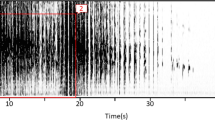Abstract
Begging behaviour of nestling birds may involve more than a simple, honest source of information for parents to use in provisioning. Many aspects of begging behaviour relate instead to sibling competition for food items within the nest, and we might expect evidence of adaptive learning and behavioural adjustment in response to experience of the competitive environment. In this study, we consider begging in different locations within the nest as analogous to foraging in different patches, varying in food availability. Using hand-feeding trials, we created zones of differing profitability within an artificial nest by adjusting either the prey size or number of items delivered, and allowed only indirect competition between pairs of southern grey shrike (Lanius meridionalis) nestlings. Nestlings demonstrated the ability to detect differences in zone profitability and position themselves accordingly. By the end of both the prey size and delivery rate trials nestlings had increased the amount of time spent in the high quality zone. Such movement in response to differences in load quality, as well as frequency, demonstrates the ability of nestlings to learn about their environment and to facultatively adjust their begging in order to maximise energetic rewards.





Similar content being viewed by others
References
Anderson DJ, Budde C, Apanius V, Martinez Gomez JE, Bird NM, Weathers WW (1993) Prey size influences female competitive dominance in nestling American kestrels (Falco sparverius). Ecology 74:367–376
Budden AE (2001) Nestling begging in Southern grey shrikes. PhD Thesis, University of Wales, Bangor
Budden AE, Wright J (2001a) Begging in nestling birds. Curr Ornithol 16:83–118
Budden AE, Wright J (2001b) Nestling diet, chick growth and breeding success in the Southern grey shrike. Proc 3rd Int Shrike Symp, The Ring 22:165–172
Butchart SHM, Kilner RM, Fuisz T, Davies NB (2003) Differences in nestling begging calls of hosts and host-races of the common cuckoo, Cuculus canorus. Anim Behav 65:345–354
Cotton PA, Kacelnik A, Wright J (1996) Chick begging as a signal: are nestlings honest? Behav Ecol 7:178–182
Cotton PA, Wright J, Kacelnik A (1999) Chick begging strategies in relation to brood hierarchies and hatching asynchrony. Am Nat 153:412–420
Fretwell SD, Lucas HL (1970) On territorial behaviour and other factors influencing habitat distribution in birds. Acta Biotheor 19:16–36
Godfray HCJ (1991) Signalling of need by offspring to their parents. Nature 352:328–330
Godfray HCJ (1995a) Signalling of need between parents and young: parent-offspring conflict and sibling rivalry. Am Nat 146:1–24
Gottlander K (1987) Parental feeding behaviour and sibling competition in the pied flycatcher Ficedula hypoleuca. Ornis Scand 18:269–276
Kacelnik A, Cotton PA, Stirling L, Wright J (1995) Food allocation among nestling starlings: sibling competition and the scope of parental choice. Proc R Soc Lond B 259:259–263
Kedar H, Rodríguez-Gironés MA, Yedvab S, Lotem A, Winkler DW (2000) Experimental evidence for offspring learning in parent-offspring communication. Proc R Soc Lond B 267:1723–2727
Kölliker M, Richner H, Werner I, Heeb P (1998) Begging signals and biparental care: nestling choice between parental feeding locations. Anim Behav 55:215–222
Kölliker M, Richner H (2004) Navigation in a cup: chick positioning in great tit, Parus major, nests. Anim Behav 68:941–948
Lessells CM, Poelman EH, Mateman AC, Cassey P (2005) Consistent feeding positions of great tit parents. Anim Behav
Lotem A (1998a) Differences in begging behaviour between barn swallows, Hirundo rustica, nestlings. Anim Behav 55:809–818
Malacarne G, Cucco M, Bertolo E (1994) Sibling competition in asynchronously hatched broods of the Pallid Swift (Apus pallidus). Ethol Ecol Evol 6:293–300
McRae SB, Weatherhead PJ, Montgomerie R (1993) American robin nestlings compete by jockeying for position. Behav Ecol Sociobiol 33:101–106
Mei N (1994) Role of digestive afferents in food intake regulation, In: Legg CR, Booth DA (eds) Appetite: neural and behavioural bases. Oxford University Press, Oxford
Milinski M, Parker GA (1991) Competition for resources. In: Krebs JR, Davies NB (eds) Behavioural ecology: an evolutionary approach, 3rd edn. Blackwell, Oxford
Parker GA, Royle NJ, Hartley IR (2002) Begging scrambles with unequal chicks: interactions between need and competitive ability. Ecol Lett 5:206–215
Price K, Ydenberg R (1995) Begging and provisioning in broods of asynchronously-hatched yellow-headed blackbird nestlings. Behav Ecol Sociobiol 37:201–208
Price K, Harvey H, Ydenberg R (1996) Begging tactics of nestling yellow-headed blackbirds, Xanthocephalus xanthocephalus, in relation to need. Anim Behav 51:421–435
Rodríguez-Gironés MA, Enquist M, Lachmann M (2001) Role of begging and sibling competition in foraging strategies of nestlings. Anim Behav 61:733–745
Rodríguez-Gironés MA, Zúñiga JM, Redondo T (2002) Feeding experience and relative size modify the begging strategies of nestling. Behav Ecol 13:782–785
Royle NJ, Hartley IR, Parker GA (2002) Begging for control: when are offspring solicitation behaviours honest? Trends Ecol Evol 17:434–440
Slagsvold T (1997) Brood division in birds in relation to offspring size: sibling rivalry and parental control. Anim Behav 54:1357–1368
Smith HG, Montgomerie R (1991) Nestling American Robins compete with siblings by begging. Behav Ecol Sociobiol 29:307–312
Stamps JA, Clark A, Arrowood P, Kus B (1989) Begging behaviour in budgerigars. Ethology 81:177–192
Tregenza T (1995) Building on the ideal free distribution. Adv Ecol Res 26:253–307
Acknowledgments
We are grateful to the Mitrani Centre for Desert Ecology, Hazeva Research and Development Centre (HRDC), Hazeva Field School, Berry Pinshow, Sasha Dall and Dror Hawlena for logistical support, Kate Lessells for access to an unpublished MS and Arnon Lotem and anonymous reviewers for comments on a previous version of the paper. A.E.B. was funded by NERC PhD Studentship No. GT4/97/288/TS. This work was carried out under license and according to ethical guidelines at HRDC in Israel
Author information
Authors and Affiliations
Corresponding author
Additional information
Communicated by M. Soler
Rights and permissions
About this article
Cite this article
Budden, A.E., Wright, J. Learning during competitive positioning in the nest: do nestlings use ideal free ‘foraging’ tactics?. Behav Ecol Sociobiol 58, 227–236 (2005). https://doi.org/10.1007/s00265-005-0940-8
Received:
Revised:
Accepted:
Published:
Issue Date:
DOI: https://doi.org/10.1007/s00265-005-0940-8




